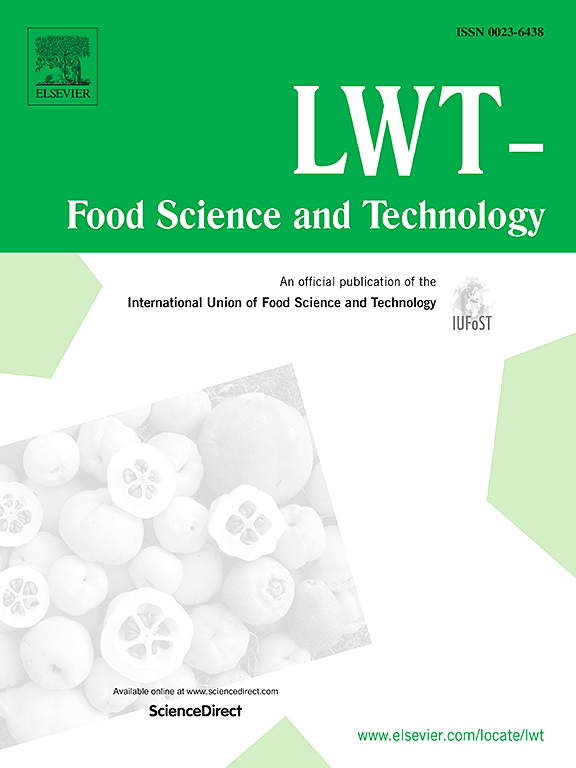Rapid identification of multiplex camellia oil adulteration based on lipidomic fingerprint using laser assisted rapid evaporative ionization mass spectrometry and data fusion combined with machine learning
IF 6.6
1区 农林科学
Q1 FOOD SCIENCE & TECHNOLOGY
引用次数: 0
Abstract
Camellia oil (CAO) is a high-value edible oil with numerous health benefits; however, its authenticity is often compromised by adulteration with cheaper oils. This study proposes a rapid and robust authenticity analysis method for CAO using laser-assisted rapid evaporative ionization mass spectrometry (LA-REIMS) with complementary analytical techniques and chemometric analysis. Fatty acid composition, attenuated total reflectance Fourier transform infrared spectroscopy spectral fingerprinting, 1H nuclear magnetic resonance spectroscopy, and color analysis were employed to characterize CAO. Although traditional methods exhibited limitations in detecting low-level adulteration (<40 %), LA-REIMS provided detailed lipidomic fingerprints with minimal sample pretreatment and high throughput. By applying both low- and mid-level data fusion strategies to combine LA-REIMS data with GC and developing eight machine learning classification models, including logistic regression, k-nearest neighbor, support vector machine, decision tree, neural network, Kalman filter, linear discriminant analysis, and random forest (RF), substantial improvements in classification accuracy were achieved. Among these, the RF model, particularly when paired with mid-level data fusion, attained an accuracy of 99.56 % in discerning authentic CAO from adulterated samples. These findings demonstrated the feasibility of a digital authenticity testing platform for enhancing food safety and quality control in the edible oil industry.
基于脂质组学指纹的激光辅助快速蒸发电离质谱及结合机器学习的数据融合快速鉴别多重山茶油掺假
茶油(CAO)是一种高价值的食用油,具有许多健康益处;然而,它的真实性经常因掺入廉价油而受到损害。本研究提出了一种基于激光辅助快速蒸发电离质谱(LA-REIMS)的快速可靠的CAO真伪分析方法,该方法与分析技术和化学计量分析相辅相成。脂肪酸组成、衰减全反射傅立叶变换红外光谱、光谱指纹图谱、1H核磁共振光谱和颜色分析对CAO进行表征。尽管传统方法在检测低水平掺假(40%)方面存在局限性,但LA-REIMS以最少的样品预处理和高通量提供了详细的脂质组学指纹图谱。通过中低层次的数据融合策略,将LA-REIMS数据与GC相结合,开发了逻辑回归、k近邻、支持向量机、决策树、神经网络、卡尔曼滤波、线性判别分析、随机森林(RF)等8种机器学习分类模型,实现了分类精度的显著提高。其中,RF模型,特别是当与中级数据融合配对时,从掺假样品中识别真实CAO的准确率达到99.56%。这些发现证明了数字真实性测试平台在加强食用油行业食品安全和质量控制方面的可行性。
本文章由计算机程序翻译,如有差异,请以英文原文为准。
求助全文
约1分钟内获得全文
求助全文
来源期刊

LWT - Food Science and Technology
工程技术-食品科技
CiteScore
11.80
自引率
6.70%
发文量
1724
审稿时长
65 days
期刊介绍:
LWT - Food Science and Technology is an international journal that publishes innovative papers in the fields of food chemistry, biochemistry, microbiology, technology and nutrition. The work described should be innovative either in the approach or in the methods used. The significance of the results either for the science community or for the food industry must also be specified. Contributions written in English are welcomed in the form of review articles, short reviews, research papers, and research notes. Papers featuring animal trials and cell cultures are outside the scope of the journal and will not be considered for publication.
 求助内容:
求助内容: 应助结果提醒方式:
应助结果提醒方式:


